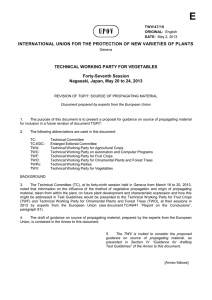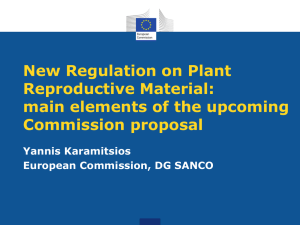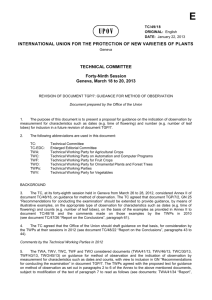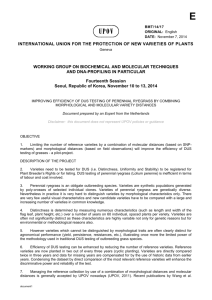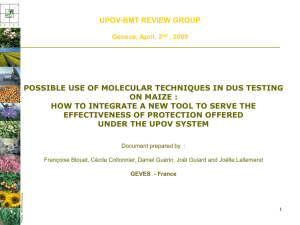Revision of document TGP/7: Source of Propagating material
advertisement
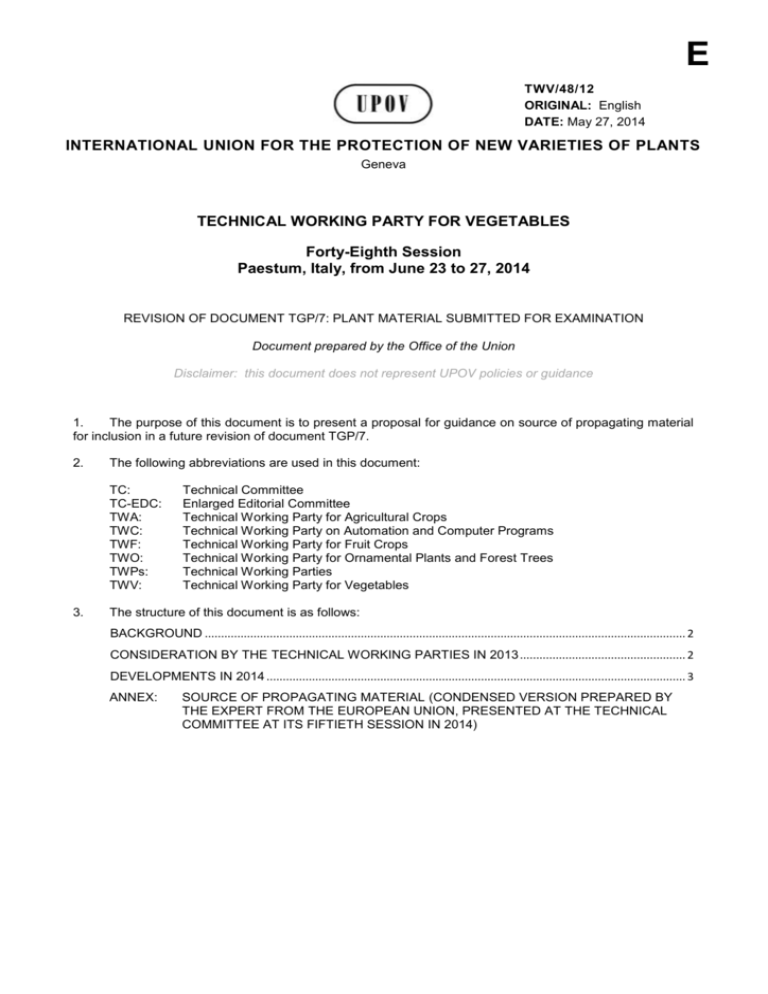
E TWV/48/12 ORIGINAL: English DATE: May 27, 2014 INTERNATIONAL UNION FOR THE PROTECTION OF NEW VARIETIES OF PLANTS Geneva TECHNICAL WORKING PARTY FOR VEGETABLES Forty-Eighth Session Paestum, Italy, from June 23 to 27, 2014 REVISION OF DOCUMENT TGP/7: PLANT MATERIAL SUBMITTED FOR EXAMINATION Document prepared by the Office of the Union Disclaimer: this document does not represent UPOV policies or guidance 1. The purpose of this document is to present a proposal for guidance on source of propagating material for inclusion in a future revision of document TGP/7. 2. The following abbreviations are used in this document: TC: TC-EDC: TWA: TWC: TWF: TWO: TWPs: TWV: 3. Technical Committee Enlarged Editorial Committee Technical Working Party for Agricultural Crops Technical Working Party on Automation and Computer Programs Technical Working Party for Fruit Crops Technical Working Party for Ornamental Plants and Forest Trees Technical Working Parties Technical Working Party for Vegetables The structure of this document is as follows: BACKGROUND .................................................................................................................................................... 2 CONSIDERATION BY THE TECHNICAL WORKING PARTIES IN 2013 ................................................... 2 DEVELOPMENTS IN 2014 ................................................................................................................................. 3 ANNEX: SOURCE OF PROPAGATING MATERIAL (CONDENSED VERSION PREPARED BY THE EXPERT FROM THE EUROPEAN UNION, PRESENTED AT THE TECHNICAL COMMITTEE AT ITS FIFTIETH SESSION IN 2014) TWV/48/12 page 2 BACKGROUND 4. The Technical Committee (TC), at its forty-ninth session held in Geneva from March 18 to 20, 2013, noted that information on the influence of the method of vegetative propagation and origin of propagating material, taken from within the plant, on future plant development and characteristic expression and how this might be addressed in Test Guidelines would be presented to the Technical Working Party for Fruit Crops (TWF) and Technical Working Party for Ornamental Plants and Forest Trees (TWO), at their sessions in 2013 by experts from the European Union (see document TC/49/41 “Report on the Conclusions”, paragraph 81). CONSIDERATION BY THE TECHNICAL WORKING PARTIES IN 2013 5. The TWO, TWF, TWV, TWC and TWA considered the proposed guidance on source of propagating material, prepared by Mr. Jens Wegner (European Union), as presented in Section IV “Guidance for drafting Test Guidelines” of the Annexes to documents TWO/46/10, TWF/44/10, TWV/47/10, TWC/31/10 and TWA/42/10 (see document TWO/46/29 “Report”, paragraphs 22 and 23, document TWF/44/31 “Report”, paragraphs 25 to 27, and document TWV/47/34 “Report”, paragraphs 25 to 27, document TWC/31/32 “Report”, paragraphs 23 and 24, and document TWA/42/31 “Report”, paragraphs 24 to 26), as reproduced in Annex I to this document. 6. The TWO agreed that it would not be appropriate to seek to insert additional standard wording on source of propagating material in the Technical Questionnaire, Section 9.2. However, the TWO noted that the document provided useful information on the effects of the source of propagating material and requested the preparation of a condensed version as a source of general guidance for drafters of Test Guidelines, for inclusion in document TGP/7 (see document TWO/46/29 “Report”, paragraph 23). 7. The TWF noted that the document provided useful information on the effects of the source of propagating material as a source of general guidance for drafters of Test Guidelines, for inclusion in document TGP/7, and requested the expert from the European Union to prepare a condensed version of the wording to be presented to the TWF at its forty-fifth session in 2014 (see document TWF/44/31 “Report”, paragraph 26). 8. The TWF invited an expert from Spain to make a presentation at the forty-fifth session of the TWF, on practical experience in the use of in vitro propagated material when submitted for DUS testing or certification schemes (see document TWF/44/31 “Report”, paragraph 27). 9. The TWV noted that the document provided useful information on the effects of the source of propagating material as a source of general guidance for drafters of Test Guidelines, for inclusion in document TGP/7, and requested the expert from the European Union, with the support of experts from France and Netherlands, to prepare a condensed version of the wording to be presented to the TWV at its forty-eighth session, in 2014 (see document TWV/47/34 “Report”, paragraph 26). 10. The TWV requested to add examples for vegetatively propagated vegetables (see document TWV/47/34 “Report”, paragraph 27). 11. The TWC noted that the document provided useful information on the effects of the source of propagating material, and agreed with the request for the preparation of a condensed version as a source of general guidance for drafters of Test Guidelines, for inclusion in document TGP/7 (see document TWC/31/32 “Report”, paragraph 23). 12. The TWC requested the drafter to avoid reference to Wikipedia in order to make sure to refer to a reliable information source (see document TWC/31/32 “Report”, paragraph 24). 13. The TWA agreed with the TWO that it would not be appropriate to seek to insert additional standard wording on source of propagating material in the Technical Questionnaire, Section 9.2. The TWA noted that the document provided useful information on the effects of the source of propagating material as general guidance for drafters of Test Guidelines, for inclusion in document TGP/7, and requested the expert from the European Union, with the support of experts from France and the Netherlands, to prepare a condensed version of the wording to be presented to the TWA at its forty-third session in 2014. The TWA noted the effects of source of propagating material on agricultural crops, such as potato, which need to be taken into account for the assessment of DUS (see document TWA/42/31 “Report”, paragraph 25). TWV/48/12 page 3 14. The TWA noted that the issues raised in document TWA/42/10 were different from the intentional use of chemicals (e.g. growth retardants) on all varieties included in the DUS trial. It recalled that the general issues were covered by the following section of document TG/1/3 “General Introduction to the Examination of Distinctness, Uniformity and Stability and the Development of Harmonized Descriptions of New Varieties of Plants” (see document TG/1/3, Chapter 2, Section 2.5.3): “The expression of a characteristic or several characteristics of a variety may be affected by factors, such as pests and disease, chemical treatment (e.g. growth retardants or pesticides) effects of tissue culture, different rootstocks, scions taken from different growth phases of a tree, etc. In some cases (e.g. disease resistance), reaction to certain factors is intentionally used (see TG/1/3 Chapter 4, Section 4.6.1) as a characteristic in the DUS examination. However, where the factor is not intended for DUS examination, it is important that its influence does not distort the DUS examination. Accordingly, depending on the circumstances, the testing authority should ensure either that: (a) the varieties under test are all free of such factors or, (b) that all varieties included in the DUS test, including varieties of common knowledge, are subject to the same factor and that it has an equal effect on all varieties or, (c) in cases where a satisfactory examination could still be undertaken, the affected characteristics are excluded from the DUS examination unless the true expression of the characteristic of the plant genotype can be determined, notwithstanding the presence of the factor.” The TWA also recalled the guidance provided in document TGP/12 “Guidance on Certain Physiological Characteristics” (see document TWA/42/31 “Report”, paragraph 25). DEVELOPMENTS IN 2014 15. The TC, at its fiftieth session, held in Geneva from April 7 to 9, 2014, considered document TC/50/17 “Revision of document TGP/7: Source of Propagating material”, including a new condensed version of draft of guidance on source of propagating material, prepared by the expert from the European Union, which is presented in Annex I to this document (see document TC/50/36 “Report on the Conclusions”, paragraph 43). 16. The TC, at its fiftieth session, encouraged experts to present to the TWPs, at their sessions in 2014, their experiences with regard to plant material submitted for examination, and how they had addressed the problems that could arise, which could be developed into guidance that would reflect good practice. It also agreed that the title of the document should be amended accordingly (see document TC/50/36 “Report on the Conclusions”, paragraph 44). 17. On April 25, 2014, the Office of the Union, issued Circular E14/105 inviting experts to provide their experiences with regard to plant material submitted for examination, and how they had addressed the problems that could arise. Copies of presentations received in response to the Circular will be presented in an addendum to this document. 18. The TWV is invited to: (a) consider the presentations of experts, on their experiences with regard to plant material submitted for examination, and the solutions that have been developed to address problems, as reproduced in the addendum of this document; and (b) consider how those experiences and solutions could be developed into guidance that reflects good practice. [Annex follows] TWV/48/12 ANNEX SOURCE OF PROPAGATING MATERIAL (condensed version prepared by the expert from the European Union, presented at the Technical Committee at its fiftieth session in 2014) I. INTRODUCTION In horticultural circles and in some agricultural crops a wide range of methods of vegetative propagation are found. On a commercial scale, the most frequently applied methods are the following: softwood cuttings, hardwood cuttings, leaf cuttings, division of rhizomes or plant clusters, runners, daughter bulbs and bulbils, micro-propagation (also known as : in vitro techniques, “in vitro culture”, and “tissue culture”; for the purpose of this documents all terms shall have the same meaning), grafting, (mini- or micro) tubers. As the method of propagation may have a direct impact on the appearance of the plants complications in the DUS testing may arise where crops are alternatively propagated by different methods of propagation. This applies in particular to the first growing cycle. Likewise, in certain crops the origin of the propagating material from within the mother plant may also have great influence on the further appearance of the daughter plants. This must therefore also be taken into account in addition to the method of vegetative propagation. Further complications may arise where vegetatively propagated varieties have to be compared to seed-propagated varieties. Document TG/1/3 “General Introduction to the Examination of Distinctness, Uniformity and Stability and the Development of Harmonized Descriptions of New Varieties of Plants” (see document TG/1/3, Chapter 2, Section 2.5.3) sets out that: “The expression of a characteristic or several characteristics of a variety may be affected by factors, such as pests and disease, chemical treatment (e.g. growth retardants or pesticides) effects of tissue culture, different rootstocks, scions taken from different growth phases of a tree, etc. In some cases (e.g. disease resistance), reaction to certain factors is intentionally used (see TG/1/3 Chapter 4, Section 4.6.1) as a characteristic in the DUS examination. However, where the factor is not intended for DUS examination, it is important that its influence does not distort the DUS examination. Accordingly, depending on the circumstances, the testing authority should ensure either that: (a) the varieties under test are all free of such factors or, (b) all varieties included in the DUS test, including varieties of common knowledge, are subject to the same factor and that it has an equal effect on all varieties or, (c) in cases where a satisfactory examination could still be undertaken, the affected characteristics are excluded from the DUS examination unless the true expression of the characteristic of the plant genotype can be determined, notwithstanding the presence of the factor.” The purpose of the document is to investigate how the method of propagation could influence the outcome of the DUS test and how to avoid wrong decisions on the compliance with the DUS requirements by proposing additional standard wording for test guidelines. II. VEGETATIVE PROPAGATION THROUGH CUTTINGS Cuttings show typical behavior for each type as well as according to the origin from within their mother plant which must be taken into account when assessing characteristics like “number of shoots”, “plant width”, “plant density” etc. TWV/48/12 Annex I, page 2 In addition – and especially for certain woody plants – topophysis and cyclophysis of the cutting must be taken into account as they do not only affect the ability to root but also their growth habit, their ability to branch and to flower. Where branches of orthotropic growing plants of a variety are used to produce plagiotropic growing plants (e.g. Abies, Araucaria, Picea and Pseudotsuga) these plants must not be treated as new varieties but merely as different growth of existing varieties. Likewise, where a plagiotropic plant produces occasionally orthotropic growing basal shoots these should not be treated as off-type shoots. Plagiotropic plants may be of great ornamental value and they may be the only plants on the market. Where orthotropic plants of the variety are not available for comparison and where it is not a variety (e.g. merely a single plant- see UPOV/EXN/VAR, paragraph 5) the DUS test will have to be carried out on the plagiotrop type. III. EFFECTS OF IN VITRO CULTURE In vitro culture may affect the expression of nearly any characteristic. Morphological and functional alterations have been reported in relation to rooting, growth habit, flowering and fruiting. DUS examiners are commonly confronted with problems like unequal growth of plants, atypical branching (loss of apical dominance), stunned or elongated shoots, loss or appearance of leaf variegation, poor flowering etc. The reasons behind these effects may lay in the size of the explant, the light regime applied, plant hormones added to the growing medium, the number of subcultures, the method of in vitro multiplication, the activation of transposons, the segregation of chimeras, somaclonal variation or any “ordinary” mutation as may also happen at any time ex vitro. Information provided by applicants to be considered in the DUS test Plant breeders have often outsourced the tissue culture propagation to specialized laboratories. Asking for details on the growth regulators applied may not only be an unreasonable administrative burden for applicants it is also of limited use for the examiner as the effects may be very complex and are often circumstantial; the impact of in vitro culture is thus hardly predictable for the design of the DUS test. However, information on the fact that the candidate variety was subject to in vitro culture may nevertheless be meaningful for the conduct of the DUS test. The following three scenarios may come into play: Scenario 1: tissue culture is the standard method of propagation meaning that all varieties propagated on a commercial scale are multiplied in vitro; the plant material being subject to the DUS test – candidate and reference varieties – came straight out of the flask without intermediate propagation: Even though the influence of in vitro culture on the phenotype may be of greatest importance its impact on the DUS test may be regarded as not being any more important than that of comparing plant material coming from different sources. Example: Phalaenopsis Scenario 2: distant mother or elite plants went through tissue culture meaning that several cycles of ex vitro propagation took place before plant material becomes subject to the DUS test: Here it may be assumed that the plant material has grown out of all late effects in vitro culture may have had. Example: Pelargonium Scenario 3: tissue culture is not the only method of propagation on a commercial scale. The plant material in the DUS trial – candidate or reference varieties – may come from different propagations: there are on the one hand the plants coming either straight out of tissue culture or they are direct descendants of such plants and on the other hand plants which were propagated conventionally. A combination of such material in trial may result in an erroneous decision on the compliance with the distinctness requirement as well as in distorted variety descriptions. The consequences for the DUS test are elaborated in following section. Example: Rhododendron, Asparagus, tomatoes and pepper Consequences for the conduct of the DUS technical examination Alterations resulting from tissue culture may be of temporary or permanent nature. Plants being permanently altered no longer belong to the initial variety and they are therefore to be treated as off-types; reference is made to document TGP10/1 (section 4: Uniformity assessment on the basis of off-types). Likewise, where variation within the sample is attributed to in vitro propagation no decision on the compliance with the uniformity requirement can be taken as the expression of characteristics is not based on the genome. TWV/48/12 Annex I, page 3 However, if all plants of a given “variety” are equally affected (such as through rejuvenation or late effect of plant hormones and other growing conditions applied) this must – in the absence of a genetic basis for the expression of the characteristics in question – not result in the grant of a title of protection. The difficulty a DUS examiner may be faced with lies in the distinction between these different alterations. In the first case the sample should be regarded as not suitable for the conduct of the DUS test (and it is up to the testing authority to either refuse the sample as being not suitable for the DUS test or to extend the growing trial over another growing period to let disappear the impact the in vitro culture had); in the second case a possibly wrongly declared compliance with the distinctness requirement will have to be corrected resulting in the nullification of a right granted. IV. GUIDANCE FOR DRAFTING TEST GUIDELINES Document TGP/7 “Development of Test Guidelines” provides standard wording with regard to the quantity of plant material required for the DUS trial but is silent on the plant quality. It is therefore proposed that a guidance note is provided to explain potential problems in the DUS growing trial resulting from the source of propagation material. Cuttings (ex vitro): For varieties conventionally propagated ex vitro – especially for crops which will not be pruned during the growing trial – Test Guidelines may have to define the type of cuttings to be used to produce the sample for the DUS trial. Options to choose from could be: (a) Plants must have been propagated through tip cuttings and must have neither been pinched nor pruned. (b) Plants must have been propagated through tip cuttings and be pinched/pruned/cut back once/twice etc or must have been propagated through softwood cuttings coming from the central or basal parts of the mother plant. (c) Plants must have been propagated through hardwood cuttings. For crops where, there are known topophysis and cyclophysis effects, requirements for the propagation material including their origin from within the mother plant must be particularly prescriptive to ensure comparability of varieties. Therefore the following guidance note, taken from TG/96/4 (Picea abies (L.) Karst.) is proposed, as an example: “…Scions [or cuttings] should be selected in a way that expressions caused by topophysis reactions are avoided.” Micro propagation: In crops where tissue culture is not the only method of propagation the Test Guidelines may specify: “The plant material supplied should preferably not be obtained from in vitro propagation”. For those crops for which tissue culture is used, Test Guidelines could – where feasible – foresee regularly more than one growing cycle (possibly with an additional propagation) which would firstly allow the examiner to detect non-declared micro-propagation and secondly to allow late effects of tissue culture to grow out and thus reduce the risk of taking a wrong decision on distinctness. V. LITERATURE: Bhat, S.R. and Srinivasan, S. (2002): Molecular and genetic analysis of transgenic plants: Considerations and approaches. Plant Science 163: 673-681 Fouad, M., Swartz, H.J. and Buta, G. (1991): The role of abscisic acid and plant growth regulators in tissue culture-induced rejuvenation of strawberry ex vitro. Plant Cell, Tissue and Organ Culture 25: 75-84 Jesch, H.-H. and Plietzsch, A. (2000): Langzeit-Leistungsprüfung in vitro vermehrter Ziergehölze (Prunus). I. Morphologische Merkmale. Gartenbauwissenschaft 65: 203-2012 TWV/48/12 Annex I, page 4 Jesch, H.-H. and Plietzsch, A. (2001): Langzeit-Leistungsprüfung in vitro vermehrter Ziergehölze (Prunus). II. Phänologische und physiologische Merkmale. Gartenbauwissenschaft 66: 61-67 Klaehn, F.U.: the relation of vegetative propagation to topophysis, cyclophysis and periphysis in forest trees. Krüssmann, G. (1997): Die Baumschule. 6th Ed. Parey Berlin Murashige T. and Skoog F. (1962): A revised medium for rapid growth and bioassays with tobacco tissue cultures. Physiol Plant 15(3): 473-497 Ochatt, S.J., Pontécaille, C. and Rancillac, M. (2000): The growth regulators used for bud regeneration and shoot rooting affect the competence for flowering and seed set in regenerated plants of protein peas. In Vitro Cell. Dev. Biol.; Plant 36: 188-193 Smith, M.K. and Hamill, S.D. (1996): Field evaluation of mircopropagated end conventionally propagated ginger in subtropical Queensland. Austr. J. of Experimental Agriculture 36: 347-54 Waldenmaier, S. and Bünemann, G. (1991): Ex vitro effects in micropropagation of Syringa L.; Acta Horticulturae 300 [End of Annex and of document]
